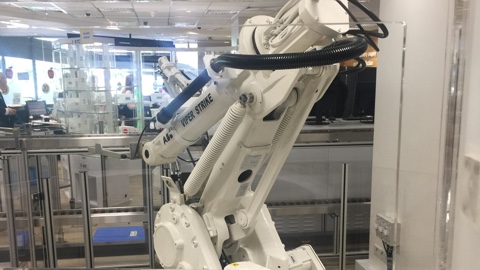
Despite the highest levels of spending in the world, Americans die younger and sicker when compared to both developed and developing nations. From the lens of smart cities, the question becomes “how can innovation create efficiencies and increase positive returns?” To explore this question, let’s compare the World Health Organization’s profiles of the U.S. versus Singapore. Why Singapore? The pwc Index of City Readiness ranks the city-nation #1 in terms of global smart cities.
People at birth in the U.S. are expected to live 79 years. In Singapore, that number is 83. The news gets worse for Americans. Compared against 17 peer countries, America ranks second both for the highest risk of dying from non-communicable diseases and for highest death rate from injuries which is dramatically affected by transportation and gun-related injuries. If you want to dig into the “why”, check out U.S. Health in International Perspectives: Shorter Lives, Poorer Health published by The National Academies of Sciences, Engineering and Medicine.
What is Singapore’s approach and what can we learn from it?
It begins with collaboration between the public and private sector to utilize technology in service of creating a better human experience. That formula may sound familiar as it is the foundation of the smart city movement.
IHiS is at the center of Singapore’s healthcare success. In 2008, 600 health IT staff gathered to consolidate practices and systems. In 2010, they launched an integrated e-medical records system with the guiding principle of “one Patient, one medical record”. All systems are designed for maximum interoperability to “streamline workflow, automate checks, enhance staff efficiency and improve patient safety and experience.” Here are some of the projects and programs from this effort:
- 200+ systems migrated over 15 months to the cloud (H-cloud) with 99.95% success rate and minimal impact to hospitals’ operations and patient treatment
- Outpatient Pharmacy System (OPAS) enables high-volume prescription loads safely and efficiently through the use of robotics to automate the prescription filling process so that pharmacists can be more engaged with patient care
- The Medical Devices Integration (MDI) solution is a software-based vendor-neutral solution that automatically collects and integrates patients’ vital signs data generated from various medical devices to the Electronic Medical Records (EMR) system wireless
- A variety of mobile applications including Nurses Pal, which enables quicker adjustment patients’ intravenous drips and helps to manage bedsores and prevent falls.
- Many more projects are available to review at com.sg
A first person account of the American system
There are many healthcare experts that can provide excellent insight to the U.S. approach, and I abdicate to their experience and knowledge. I can, however speak about what it is like to experience the U.S. system, so I’ll speak from that perspective.
Several things I need to admit upfront. I have full, excellent healthcare coverage and am in optimal health. My two healthcare-related incidents this year were for preventative exams and an advanced case of poison ivy. I am very aware that I am the lucky one.
And still, my experiences in both cases point to the brokenness of our healthcare system that suffers from fragmented industries that rely on legacy infrastructure. I spent hours trying to untangle a confusing web to determine which care options were available, what was covered, what was my responsibility and even down to the pharmacy level, what prescriptions could be fulfilled.
Healthcare providers don’t efficiently connect with each other much less the insurers. My experience was for simple, routine and non-serious healthcare. I cannot imagine the frustration and hassle for those with more serious conditions.
And so it is no wonder that healthcare is the leading cause of bankruptcy in the U.S. event though we out-spend every other nation on the planet which amounts to $10,348 per person or roughly 18 percent of our gross domestic product.
We must do better.
It is imperative that we move the conversation away from the political noise and blame and instead look toward how we can come together to increase efficiencies and enable technology-led solutions in service of humans.
And we can learn a lot from Singapore whose aim is “to improve the population’s health and health administration by integrating intelligent, highly resilient, and cost effective technologies with process and people.” IHiS has oriented around “one bill for the patient’s entire day’s visit, to give them a hassle free experience.” Can we dream of a healthcare system such as this in the U.S.?
There are many who are working towards solutions.
Here are 10 CEOs Who are Transforming Healthcare in America. And Clinton Leaf (Fortune) writes, “The question is whether healthcare can likewise be wrenched free from its rigid, decades-old payment and provider constructs and be re-formed into new self-contained, efficiently run ecosystems that put the consumer at the center. I believe the answer is yes—and that we’ll start seeing business models (both for-profit and not-for-profit) emerge and evolve around this idea.”
But it requires coordination and cooperation with government, not in spite of it. In Singapore the Prime Minister’s Office (PMO) oversees the Smart Nation and Digital Government Office (SNDGO), which “drives the digital transformation of government, builds long-term capabilities for the public sector, and promotes adoption and participation from the public and industry, to take a collective approach in building a smart nation.” This group collaborates with GovTech Signapore as the implementation arm to work across domains and geographical areas. SNDGG handles regulatory and policy issues such as privacy, data sharing, and more.
They focus on three key areas: cashless e-payments, digital ID authentication, and a smart nation sensor platform. They extend from these national priorities to specific areas through various agencies including Healthcare through the Ministry of Health. Each organization knows their role and executes accordingly.
Singapore is a small city-nation that is vulnerable to outside threats. And so they are clear their chance for survival depends on embracing innovation. They accept that this era requires us all to live in a constant state of disruption and redefinition.
In a previous article I wrote: “when you see this kind of commitment, it puts all other approaches into question.” My focus was on Singapore’s investment in digital infrastructure (broadband, mobile and wifi capacity). But my question lingers now related to healthcare.
Our current system is on a lifeline and with the aging and sickening population, it is no longer enough to accept that status quo. Our very lives and the prosperity of our nation depends upon it. Let’s look to other nations, other systems and begin the smart transformation.
Chelsea Collier participated in a tour of Singapore in May 2017 care of GovTech and IMDA Singapore.


